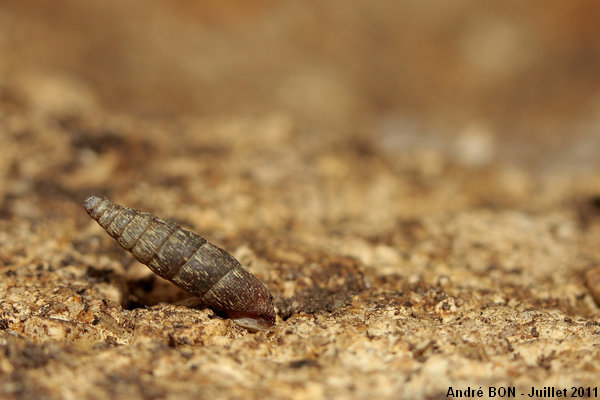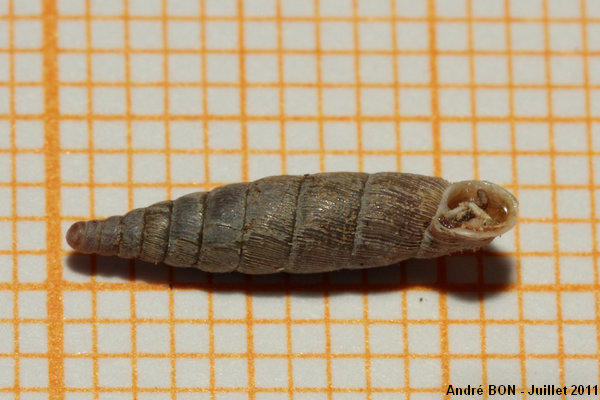


| Two Toothed Door Snail (Clausilia bidentata (Strøm, 1765)) |



|
|
Scientific name: Clausilia bidentata (Strøm, 1765) Common name: Two Toothed Door Snail French name: Clausilie commune Order: Stylommatophora Size: Length: 9-12 mm; Maximum width: 2.3-3 mm. Habitat : Forests, hedgerows, gardens, waste lands, under the litter, under stones or in crevices, on tree bark. Food: This gastropods moves out of its hide during wet weather or at night. It climbs up on bare surfaces where it feeds on lichens and microscopic algae. Reproduction : Cross-fertilizing hermaphrodite. Geographic area: Europe. The Clausilia bidentata bidentata subspecies is found in most Europe including Scandinavia. The Clausilia bidentata abietina subspecies is found in Spain. The Clausilia bidentata crenulata subspecies is found in France and in Italy. The Clausilia bidentata moniziana is found in Portugal. |
It is very easy to tell apart member of the Clausiliidae family. They show a left-handed (sinistral), long, fusiform shell with many whorls. The last whorl is slightly longer than the previous one. The opening is small and shows teeth. It can be closed by a mobile plate called Clausilium. It is much more difficult to tell species apart. There are about thirty species in France and more if you consider subspecies. There are identification keys based on the shape of the shell and in particular on plates and teeth located near the opening and a little inside (you need to make a notch). The Two Toothed Door Snail has a dark brown or reddish brown striated shell. The tip is paler. It shows narrow ribs, about 10 to 11 per mm. The diameter continuously increases on the first whorls. It reaches its maximum on the penultimate whorl. Here are some elements to guess the possible species based on the general size and shape of the shell (less rigorous method than the one based on the examination of the plates and teeth of the opening, then more subject to erroneous conclusions). Considering a total length of about 12 mm and a diameter of 3 mm, we can reduce from 46 possible subspecies to 18 possible subspecies. For example, Balea perversa is a smaller size (7 to 10 mm). Furthermore its shape is slightly different, the maximum diameter is on the last whorl. The numerous Clausilia rugosa subspecies never show a shell diameter over 2.5 mm. The Plaited Door Snail (Cochlodina laminata) is a larger size, from 15 to 17 mm. The second step is based on the geographical distribution. I will first limit the analysis to central and northern France. Then there are only 4 potential subspecies left, Clausilia bidentata bidentata, Clausilia bidentata crenulata, Clausilia dubia dubia and Macrogastra plicatula plicatula. |
| [To know more about the Two Toothed Door Snail] [Next picture] [Top] |

|
I have found these small hidden Door Snails by looking at the underside of stones in my garden. My first research led me to the probable species Clausilia bidentata, subspecies Clausilia bidentata bidentata or Clausilia bidentata crenulata. I have still a doubt with Clausilia dubia dubia and Macrogastra plicatula plicatula. I will try to do new observations and have a close look at the plates and teeth near the opening of the shell. |
| [To know more about the Two Toothed Door Snail] [Next picture] [Previous picture] [Top] |

|
I have found this empty shell under a stone. Unfortunately I have not shot any close-up picture of the opening. |
| [To know more about the Two Toothed Door Snail] [Previous picture] [Top] |

|
Now that I know that the size of the shell is an important key to tell gastropod species apart, I have always some graph paper with me. So here, the size of this fusiform shell is 11.8 x 3 mm. |